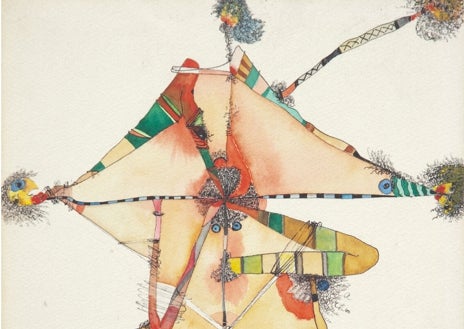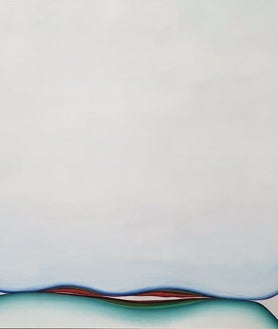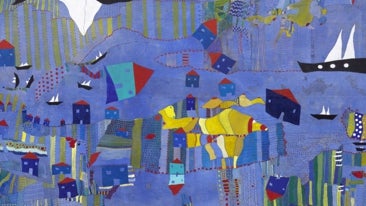The painting, the easy word game is worth, has painted little in the Reina Sofía Museum In the last years. The Duchampian ghost avoided the toxic smell of treem and, in addition, institutional passwords (‘conceptualism’, ‘archive’, ‘agency’ or ‘decolonization’) were not appropriate for the … that pigments use on a tense surface. When he welcomed the pictorial, he was in the form of a tendon, as happened for long months at the Velázquez Palacio del Retiro with Vivian Suter.
The painters seemed not so much the disinherited as the anachronics who were not able to get out of their poor and obtuse minds. If, in addition, the dire destiny of being Spanish and continuing to paint was added, it was clear that the only thing left was the complaint or melancholy to the doors of the temple of the aesthetic truth revealed.
But, suddenly, the almost Kafkian doors of the MNCARS open to offer the first retrospective in Europe of Huguette Caland, born in Beirut in 1931, HIJA DE BECHARA el Khoury, that he was the first president of Lebanon, in power from 1943 to 1952. Surprises the enthusiasm that the works of this creator raised that, in my opinion, they have no other interest than the anecdotal or geo-aesthetic-strategic.
Every so often you have to ‘discover’ forgotten ‘figures’ or allegedly marginalized, and there is no lack of decolonizing discourse that, inertially, reveals exoticing approaches. Now it’s time to legitimize and praise to the hyperbole to a pretty mediocre painter who enjoyed family privileges and the power that the Maronite Catholic elite had in his homeland.
The laudable is not meritorious in itself
In his first exhibition, made in 1972 to give the fan (Beirut), he invited A group of Palestinian refugees from the fields of Sabra and Chatila that he carried in two buses; A year earlier he had collaborated in the foundation of an NGO to help these women make a living with their embroidery and keep their cultural traditions and collective memories. Loble humanitarian work, without a doubt, that, on the other hand, it does not necessarily imply that Caland carried out meritorious works. On the contrary: what perpetrated were anodine or clumsy geometric compositions.
Of those pieces that allude to the practice of embroidery, some of which also presented in 1972 in The Delta Gallery of Rome In a sample dedicated to sixteen Lebanese painters, he went to the series ‘Bribes de Corps’ (1973), in which he sedes the corporality with curved shapes of a certain sensuality, trying to convey eroticism, appearing the soft and soft, drawing folds. Calandwithout intensifying your plastic proposal, It oscillated between the abstract and the concrete, understanding that the change of registration had to do with a matter of scale when looking at things.
«Life,” Huguette Caland writes – is concrete because we belong to a body. It is abstract because we know we are dying. According to the interpreters of this creator’s work, tended to confuse art and life, being determinants the meetings and lovers he had. Manuel Segade suggests that the painter’s work, which lax adjectivates as “hybrid”, investigates “in the imbrication between the biographical and the political, between intimate and collective memory, or to put it in psychoanalytic terms, between the financial and libidinal economy.” A tremendous mystification crosses the recovery of a Lebanese who He had the economic and family possibility of being cosmopolitan. When in his work he warns that “money does not give happiness, but contributes greatly” (1994-95), he knew, even cynically, what he meant.


From top to bottom, some of the caftans that the artist developed with some great firms; ‘Homage to Pubic Hair’; And ‘Check Point (Corps Broads)’
In a brilliant and dense essay, Hannah Feldman He points out that Caland takes the language beyond the patriarchal order, approaching the painter to the approaches of the Moroccan writer Abdelkébir Khatibi that, in ‘A note on the calligraphic sign’ (1973), or in her subsequent inquiry about the Berber tattoo, formulated an alternative deconstructive semiology in which the term intersectic ‘combination is crucial Meaning is created and at the same time intertwines with the own thing that originates it. This deployment of ‘interpretosis’ ends up assimilating Caland’s aesthetics nothing more and nothing less than with dark matter, unlikely astrophysical reference that can also connot what smells bad.
Marwa Arsanios considers that Caland’s abstractions can “melt hegemonic social abstractions (for example, the Nation State and its economic and political institutions) until they make them liquid.” It seems that the imaginary of this artist would have to do with The prohibited things and especially with politics that “it is not a girls’ thing.” The parents who portrayed in 1978 frontally with their eyes open as if they were before the Gorgon and those aunts of which he painted his legs below the table in 1991 were a world of conventions that would have driven Caland towards vital transgression and anti -systemic inspiration.
Everything sounds like opportunistic distortion to convert a ‘bonne living’ into a figure to which It is renamed with the elastic term of ‘queer’. This strange process of legitimation of an inconsequential painter is dramatized ‘thanks’ to the recent Israeli offensive in Lebanon who has led to some works, including ‘a life in a few lines’ (1992) they could not travel for the exhibition.

HUGUETTE CALAND
‘A life in a few lines’. MNCARS. Madrid. C/ Santa Isabel, 52. Commissioner: Hannah Feldman. Collaborate: Deichtorhallen Hamburg. Until August 25. A star.
One more cross point in this story of the ‘discovery’ that, with huge slack as the caftan that wore so much Caland, hides a body of bad works.
#life #lines #Huguette #Caland #legitimize #inconsequential


